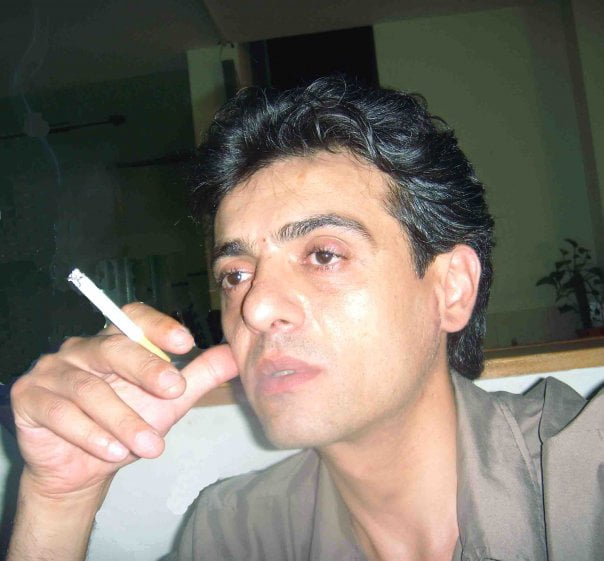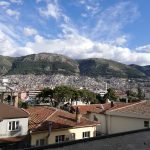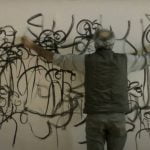Wael Tarabieh is a professional artist and art educator living in the Golan Heights -also called Golan Plateau, or Al-Jawlān, هَضْبَةُ الْجَوْلَانِ in Arabic-.

photo©Melissa Gronlund
He warmly welcomes us to Fetah Al Mudares Art Centre, formerly Bait al Fen, at the heart of Majdal Shams’ arts scene.
To begin with, Wael, can you tell us a little bit about yourself and your professional art journey?
After I finished high school, I joined the faculty in Haifa University where I studied arts and psychology for one year. Afterwards, I received a scholarship to continue my higher education in the Soviet Union. I travelled abroad and studied in the Academy of Fine Arts in Leningrad. I spent two years in the painting faculty and 16 years in the graphic’s department. In particular, I focused on Lino cuts as my specialisation.
I also developed a huge interest in mythological influences in art — The Epic of Gilgamesh was my favourite text and became the focus of my project when I finished studying.

You mentioned that you began your career abroad. Did you always plan to continue your career in the Golan Heights?
My initial plans were to return to Russia after spending a few months with my family. I was convinced that I could only be an artist outside of my hometown. However, within the first few weeks of my stay in the Golan, a group of young people asked me to organise an art course. In October 1996, I began with a very modest course of 10 people. I taught composition, painting, drawing techniques, etc. In fact, over the past few decades, I haven’t had much time to create my art, I’ve been very focused on teaching.
Does the Golan Heights’ sociocultural context play an important role in motivating you to be an art educator?
Yes, because it’s actually quite difficult to be an artist where there is no artistic environment. I was educated abroad, my first teachers were educated in Damascus — there was a very small local community to begin with. But it’s my conclusion that it’s the responsibility of current artists to create this environment for the next generation.
That’s why from 1996 to 2013, I was part of the founding team for the House of Arts in the Golan Heights. We expanded constantly — from exclusively fine arts education to teaching music, literature, organising film screenings, etc. It was a key part in developing the art community into a collaborative space that we could all engage with.

Can you tell us a little more about these developments in the artistic community? What specifically has changed since the founding of the House of Arts?
Certainly. The House of Arts, along with other artists who were collaborative in that time, was very important in creating a space for learning for two decades. It was beneficial on a social level — we didn’t feel so isolated anymore. It was also beneficial because we could all learn from one another and were exposed to more ideas and schools of thought. The artistic language in the Golan is very developed now: we do not focus on basics such as realism vs romanticism but can understand the nuanced perspectives in each other’s work.
This is because many of the founding artists in our institution attended art schools outside the Golan – in Damascus, Israel, Italy, Germany and so on. Local artists, on the other hand, received their primary influences from the Palestinian art community, which has been very welcoming of Jawlani artists. These different art styles have been exchanged among artists to create new expressions.
Additionally, because of the uniquely isolated nature of the Golan Heights, there has not been a huge carrying on of indigenous or folk artistic styles in our community. Movements like ours (in the 90s) started forming closer ties with Arab artists near us.
That’s why a lot of our students are now active in Palestine, and we regularly have collaborative exhibitions with Jordanian artists. The intersection of all of these artistic languages, as well as the varied education of the older generation, has created a very distinct and diverse Golan approach to art.

photo ©Melissa Gronlund
Wael, you’ve discussed a distinct change within the Golan artistic environment, have you been able to create similar change within the Druze community as a whole?
We engaged a lot with the local community, mostly through exhibitions and festivals. For example, in 2007, we developed an initiative to have an annual sculpture festival in different villages in the Golan. We exhibited work for 2-3 weeks every year for 3 years. At the end, we gifted a work to the village that hosted our festival. The idea was to challenge the false idea that artists are in some way only working for the elite. Breaking this idea of superiority has been a key part of our mission.
We also had a big gallery space within the House of Art itself that was open for exhibitions.
This achieved collaboration between the local community and multiple artists at the same time — we were able to address lots of stereotypes at once.
Do you think this renewed engagement with art is driven by the political context of the Golan?
Yes absolutely because art cannot be separated from reality. Politics always shapes the culture. For example, from 2011 onwards, a lot of our artists became engaged in civil unrest in Syria by using their art as a voice. Despite us being in an occupied territory, artists felt connected to their homeland and were part of the politics there. Since this resulted in a lot of split views, we had to close down our centre in 2013.
On a local level, the realities of the uprisings led to a sort of violence that seeped into the youth — art was no longer seen as a peaceful expression. This, combined with the fact that we have created art spaces for people who haven’t gone to art school, is why art from the Golan is distinct.
In certain cases, Golan society appears through contradictions: in terms of awareness, identity, belonging and sense of the metaphysical and spiritual time, the Syrians of the Golan live in their ‘Syrian’ imagination or in the traditions and history they cherish, as if they were outside the time of material modernity that accompanied the occupation.

photo © Ryan Inouye
Finally, Wael, what do you think has been the key takeaway from your involvement in the Golan Heights arts community?
I think I’m now biassed towards art that uses reality and, particularly, the negative contexts to tell a story. I studied art in an academy but have seen artists who didn’t create
meaningful art because of where we’re situated. It’s an unexpectedly vibrant art community — in a population of around 25,000 residents, we’ve seen hundreds of artists ‘graduate’ from our programmes. That vibrancy comes from using reality in their art.
In terms of the daily reality of Jawlani artists, for example, they are involved in the structural margins of the worlds of colonial modernity; they keep pace with new ideas and ways of living and face the material, bureaucratic and moral challenges imposed on them. These are the themes that many Jawlani artists deal with in their works — the themes that I believe have become essential in communicating through their art.
🌿

Interview by Vedika Madapati



